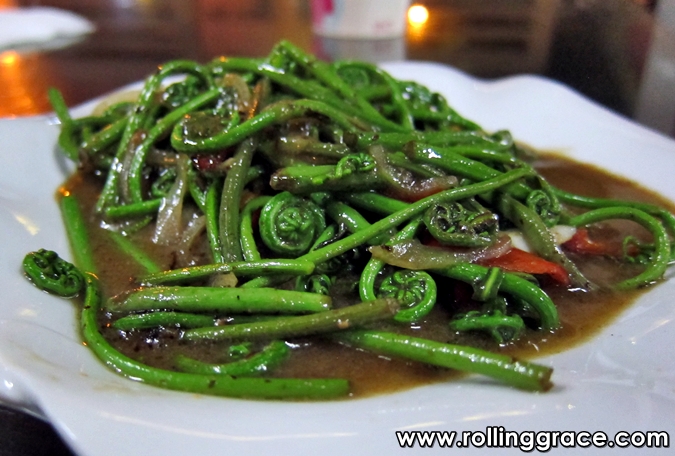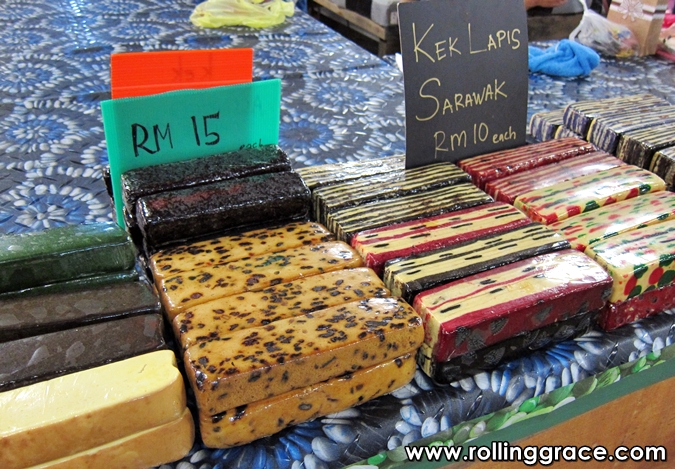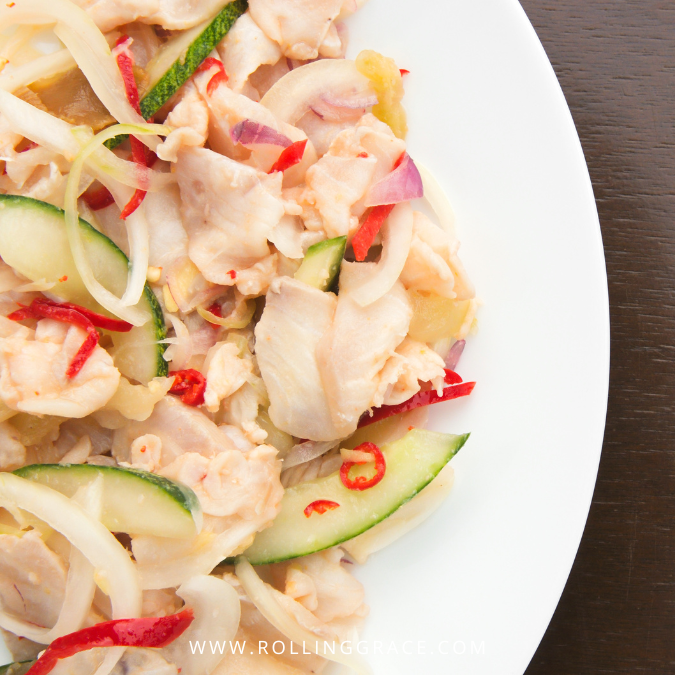Other ingredients such as fried tofu, fishcakes and bean sprouts are commonly added too. You’ll notice a small saucer filled to the brim with spicy shrimp paste sambal and half a lime - use them unsparingly to bring the taste of the broth to the next level!
Read also:
Sarawak Laksa: The Unique Dish of Sarawak
 |
| You must try Sarawak Laksa when visiting Sarawak, Malaysia |
Wild Durians
Trying the wild durians of Sarawak is a very unique and memorable experience. The villagers gather the fruits from the deep forests of Borneo. The wild variation is usually smaller in size compared to the ones found in West Malaysia.
The red-fleshed durian, also known as ‘sukang’, has long, curved spikes while the flesh has a deep caramel or roasted almond flavour. Another type of wild durian called ‘dalit’ has short, sharp spikes with orange flesh. The taste of ‘dalit’ is rather bland though it emits a turpentine-like odour.
 |
| Unique wild jungle durians of Sarawak, with beautiful red flesh |
Kway Chap
This delightful dish showcases flat rice noodles, lovingly known as "kueh," swimming in a luscious dark gravy called "chap." The magic happens through hours of slow cooking, resulting in tender and succulent mixed innards and a medley of pork cuts. It's a simple yet soul-warming creation that promises comfort with every spoonful.
Originating from the Teochew community, Kueh Chap is a testament to the art of slow cooking, allowing flavours to meld and develop over time. Imagine a steaming bowl in front of you, filled with silky noodles drenched in the rich, robust chap gravy. Each tender morsel of mixed innards and pork delights the palate, offering a symphony of textures and tastes.
This dish is not just a culinary masterpiece; it is a comfort food that warms both body and soul. With every savoury mouthful, you'll find yourself transported to a place of gastronomic bliss. Kueh Chap is the perfect remedy for a chilly evening or a hunger that craves satisfaction. Pair it with a strong cup of Chinese tea, and you have a meal that embraces you in its comforting embrace.
 |
| Kueh Chap in Sarawak, Malaysia |
Mee Kolok
A local favourite dish of springy hand-tossed egg noodles that comes with minced meat, fried shallots, bean sprouts, chopped spring onions, and slices of ‘char siew’ or barbequed meat slices. You can also find halal alternatives for the dish, where chicken is used instead. Mee Kolok is often served with a bowl of warm and clear chicken soup.
 |
| Mee Kolok in Sarawak, Malaysia |
Manok Pansuh
A traditional Ibanese and Bidayuh dish, Manok Pansuh is a way of cooking chicken or ‘manuk’ inside a bamboo known locally as ‘pansuh’. The bamboo stalk is filled with chicken pieces, water, lemongrass, and seasonings. It is then covered at the top using a lid made naturally of tapioca leaves from the cassava plant.
The bamboo is then cooked over an open fire, effectively preserving the natural flavours within. The cooked meat comes with a splendid taste as it is infused with the subtle fragrance of lemongrass and bamboo.
Manok Kacangma
Manok Kacang Ma is a unique dish with Chinese origins. It is made using the healthy and nutritious Motherwort herbs known locally as ‘Kacang Ma’. Combined with a generous amount of ginger, it is then slowly boiled in a pot with chicken to extract the earthy flavours and goodness from the ingredients. For some, this hearty soup can also benefit those with menstruation problems as it is effective in easing blood circulation.
Pucuk Midin
Pucuk Midin is a type of jungle fern shoots. In Sarawak, it is typically stir fried with spicy shrimp paste, garlic, and chillies to make up a simple yet delicious dish. The taste of Pucuk Midin is just as sweet as spinach, and it is a very popular choice at Nasi Campur stalls around town.
 |
| Pucuk Midin Belacan in Sarawak, Malaysia |
Manicai
Manicai or ‘Cangkuk Manis’ is a type of herbs used by the Hakka Chinese to prepare a healthy rice vermicelli dish. This popular Manicai salad dish is a beautiful combination of rice vermicelli stir-fried with eggs, chicken slices, fish cakes and manicai. Light yet wholesome, it can be enjoyed at any time of the day!
 |
| Manicai dish in Sarawak, Malaysia |
Kek Lapis Sarawak
The famous Kek Lapis Sarawak is a thinly striped layered cake with an interesting mix of different flavours, colours, and patterns. Apart from the traditional square cakes, you can also find rolled and triangular versions today. The price of Sarawak layered cakes varies according to the ingredients used (those made using butter are typically twice as expensive than margarine), as well as the complexity of the pattern. Local favourites include the Lapis Evergreen, Lapis Masam Manis, and Lapis Insang Pari.
 |
| Kek Lapis Sarawak in Sarawak, Malaysia |
Sago Worms
Sago worms are grubs or larvae of snout beetles that chew on the sago palm. They look like giant maggots with yellowish white segmented ring bodies. When eaten raw, sago worm tastes creamy as it has a custard-like flesh. However, when fried, grilled or roasted, the taste transforms to resemble that of salty bacon. Considering sago worms as insects, it makes it challenging for some to try them. However, researchers have proved that sago worms are highly nutritious. Afterall, its main food source only comes from the sago palm.
 |
| Eating sago worms in Sarawak, Malaysia |
Gula Apong Ice-cream
Gula apong is a sugary syrup made from the sap water collected from mangroves or the ‘Nipah’ trees. Unlike other traditional sugar products that often appear as solid crystal lumps, gula apong comes in a form of thick and brown molasses syrup. It is bitter, sweet, and has a slightly salty taste since the nipah palms are always bathed in saline water. At many ice-cream shops in Sarawak, you can easily find gula apong flavoured ice-cream.
 |
| Aiskrim Gula Apong in Sarawak, Malaysia |
Buah Dabai
Buah Dabai is a seasonal black olive fruit from Sarawak. It has an oblong shape with thin, edible black skin. You’ll find yellowish white flesh with a three-angled seed in the middle. Buah Dabai has to be soaked in hot water before you can enjoy its creamy flesh. Bonus: The nut withinthe seed can also be eaten!
Feeling adventurous? Check out the special menu at local restaurants in Sarawak and try the Dabai Fried Rice!
 |
| Buah Dabai sold at Sarawak, Malaysia |
Sarawak Famous Snacks: Tebaloi
Tebaloi is a traditional Melanau sago biscuit snack made using sago flour, desiccated coconut, eggs, sugar, and turmeric. The dough is then placed on large banana leaves and flattened with a rolling pin before it is cooked on hot embers for approximately 20 minutes. It is then cut into squares and stacked with heavy wooden blocks to flatten the biscuits further, before being dried inside a wooden stove for a crispier texture. Tebaloi is best enjoyed with a cup of hot coffee.
Umai
Umai is a native traditional Melanau dish made by combining raw fish with thinly sliced onions, bird's eyes chillies, salt, and freshly squeezed calamansi juice. The calamansi juice cures the fish while giving it an elegant and sourish taste - just like Thailand’s kerabu or the Peruvian seafood ceviche.
The most common type of fishes used to make umai are anchovies, black pomfrets or mackerels. There are also other types of seafood umai, such as those made using prawns and jellyfish, which are available depending on the season.
 |
| In Sarawak, Umai is a native traditional Melanau dish made using raw fish. |
Ikan Terubuk Masin
Ikan Terubuk is a medium-sized, scaly fish with oily skin and a million bones - metaphorically! Unlike other salted fish, Ikan Terubuk Masin from Sarawak is not preserved through drying. Instead, it is kept wet and salty. To serve, the fish is deep-fried along with all the scales. This is yet another appetite booster and a lovely side dish for warm, white rice.
 |
| Ikan Terubuk Masin in Sarawak, Malaysia |
Bubur Pedas
This delightful delicacy is commonly prepared during the holy month of Ramadan and originated in neighboring Indonesia. It's a flavorful medley of potatoes, succulent beef chunks, earthy black fungi, crispy dried tofu skin, and delicate tang hoon noodles, all simmered to perfection in a velvety broth.
Don't be deceived by its fiery name! Bubur Pedas may be "spicy porridge" in literal translation, but its sumptuous taste is reminiscent of a hearty vegetable dhal curry. This dish doesn't rely on traditional curry spices; instead, it blends a unique combination of galangal, ginger, shallots, turmeric, and chillies to bring out its delicious flavor.
Bee Hoon Belacan
This simple yet delightful noodle dish packs a flavourful punch, thanks to the local Sarawakian shrimp paste known as 'belacan'. The paste is used to flavour a sweet broth that perfectly complements the tender rice vermicelli. And the toppings? They're a feast for the senses! Julienned cucumber brings a refreshing crunch, century egg adds an indulgent creaminess, cuttlefish slices offer a savoury bite, and calamansi gives a zesty tang.
But what exactly is belacan, you might ask? It's a traditional ingredient made from mashed up shrimp that has been fermented and dried, resulting in a pungent and salty paste. When cooked, it releases an umami-rich taste that will transport you straight to the heart of Sarawakian cuisine.
Terung Dayak
Imagine wandering through the lush, untamed jungles of Borneo, filled with an array of exotic flora and fauna. Amongst this vibrant wilderness, a unique fruit awaits your discovery: Terung Dayak, a hairy, yellow and round brinjal that hails from the heart of these wild lands.
Terung Dayak is a captivating ingredient that has captivated the locals of Sarawak. In recent years, many have taken to cultivating this remarkable fruit on their very own paddy fields, bringing a touch of the jungle into their homes. It's a testament to their deep connection with the land and their commitment to preserving local traditions.
But what makes Terung Dayak truly special? It's not just its distinct appearance and origin - it's also how it is used in local cuisine. This luscious fruit finds its way into sour soups, where its unique flavour adds a delightful tang. Imagine the perfect blend of sour and savoury, with a hint of sweetness, as you savour each spoonful. And to elevate the experience even further, locals often pair Terung Dayak with dried shark meat or salted fish, adding a depth of umami to the already rich and complex flavours.
 |
| Terung Dayak in Sarawak, Malaysia |
Nasi Aruk
Nasi Aruk is a one-of-a-kind fried rice that is cooked without any oil, resulting in a smoky and slightly charred flavour that is truly unique. The magic of this dish lies in its humble ingredients, which include anchovies, onions, pepper, and salt only. It's a testament to the power of simplicity, where each ingredient shines through to create a perfectly balanced and flavourful experience.
But don't let its simplicity fool you! Nasi Aruk packs a punch when it comes to flavour, and it's all thanks to the accompanying sides. A serving of shrimp paste sambal adds a spicy kick, while salted fish offers a burst of umami. These components work together in harmony, elevating the dish to new levels of culinary excellence.
And the best part? You can recreate this dish right in the comfort of your own home! With just five ingredients and a bit of culinary expertise, you can experience the magic of Nasi Aruk for yourself.
Fried Oyster Omelette
Have you ever tried the delightful Or Chien, a crispy Chinese omelette that will tickle your taste buds with its succulent oysters? This dish is a crowd-pleaser, made for sharing and perfect for those looking to embark on a culinary adventure.
Picture this: a golden and crisp pancake, filled with plump and juicy oysters that take centre stage. Each bite offers a delightful contrast between the crunchy exterior and the tender, flavourful oysters within. It's a symphony of textures and tastes that will leave you wanting more.
Or Chien is best paired with a zesty chili paste and a juicy wedge of lime. The spiciness of the paste adds a kick that perfectly complements the richness of the omelette, while a squeeze of lime brings a refreshing zing. The combination is a taste sensation that will awaken your palate.
 |
| Golden and delicious fried oyster omelette in Sarawak, Malaysia |
Do you have a mouthwatering dish that you'd like to see featured on our list? Waste no time and reach out to us at
editor@rollinggrace.com. Our dedicated team can't wait to hear from you and will swiftly take care of your request!

























Yay!!!!!!!!!! Sarawak is a food heaven. I've tried most of these food before. I paling rindu ice cream gula apong. Good post! Thank you for sharing.
ReplyDeleteNow you are making me salivating at the thoughts of all these food. I want to go back to Sibu and eat all these (except ulat mulong hahaha).
ReplyDeleteBanyak juga yang khai pernah try makan except ulat mulong tu lah hahaaha. Apa eh rssa dia tengah tertanya apa rasanya
ReplyDeleteI haven't tried much of sarawak food yet. But Mee kolok, Laksa sarawak and ulat sago I've tried before. Haha need to travel more to sarawak to try others
ReplyDeleteFuhhhh menyelerakan! Rasanya semua i pernah cuba. Paling buat mengidam adalah ais krim gula apong tu. Bila rindu, pergi kampung baru, kl pun jadi le. Sedappp.
ReplyDeleteMarsha makanan Sarawak pernah cuba laksa sarawak, mee kolok, kek lapis dan pucuk midin je. Yang lain belum. Bab ulat sagoo tu kena pikir banyak kali....hihi
ReplyDeleteOh noooo! drooling reading all the list except one.. so far i tak pernah try lagi :P the ulat sago.. my grandma really enjoy it tho!
ReplyDeleteBanyak makannan Sarawak i tak cuba lagi.. Macam2 ada ye.. Ketinggalan sungguh nad ni.. Kek lapis je pernh makna. Hahaha. Nampaknya kene cari kat kl ni makanan Sarawak
ReplyDeletedurian tu dah pernah try, but not my liking hehe. mee kolok tu memang favourite lah, tak jumpa lagi yang sedap kat sini
ReplyDeleteTeringin nak try Manicai tu , nampak macam Mee Celup aje kann.. tapi ulat tu adoiiii pernah depan-depan kawan makan dan telannya, terus Sis rasa nak pengsan kat situ...
ReplyDeleteYay! I dah tick most of the food up there, including the Sago worm. I remember how wierd the worm tasted haha.
ReplyDeleteI love Sarawak laksa and mee kolok the most. It's hard to find good, authentic ones here in Semenanjung. But there seems to be a lot more Sarawakian food I haven't tried.
ReplyDeleteSedapnya menu makanan Sarawak. Yaya pernah ke Miri dulu sebab ada kenalan ayah disana masa ayah berkhidmat jadi polis disana. Ayah yaya ajar makan laksa sarawak memang sedap. Nasi lalapan pun sedap. Ayah yaya dah pandai speaking Sarawak dengan fasihnya hee
ReplyDeleteWah so many food to try in Sarawak, i tried so of them and the one that I really want to try is Sago Worm.
ReplyDeleteThis comment has been removed by a blog administrator.
ReplyDeleteThis comment has been removed by a blog administrator.
ReplyDeleteThis comment has been removed by a blog administrator.
ReplyDeleteThis comment has been removed by a blog administrator.
ReplyDeleteThis comment has been removed by a blog administrator.
ReplyDeleteThis comment has been removed by a blog administrator.
ReplyDeleteThis comment has been removed by a blog administrator.
ReplyDeleteThis comment has been removed by a blog administrator.
ReplyDeleteThis comment has been removed by a blog administrator.
ReplyDeleteThis comment has been removed by a blog administrator.
ReplyDelete